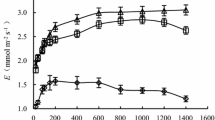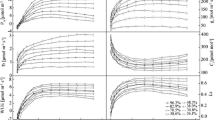Abstract
To clarify the changes in plant photosynthesis and mechanisms underlying those responses to gradually increasing soil drought stress and reveal quantitative relationships between photosynthesis and soil moisture, soil water conditions were controlled in greenhouse pot experiments using 2-year-old seedlings of Forsythia suspensa (Thunb.) Vahl. Photosynthetic gas exchange and chlorophyll fluorescence variables were measured and analyzed under 13 gradients of soil water content. Net photosynthetic rate (P N), stomatal conductance (g s), and water-use efficiency (W UE) in the seedlings exhibited a clear threshold response to the relative soil water content (R SWC). The highest P N and W UE occurred at R SWC of 51.84 and 64.10%, respectively. Both P N and W UE were higher than the average levels at 39.79% ≤ R SWC ≤ 73.04%. When R SWC decreased from 51.84 to 37.52%, P N, g s, and the intercellular CO2 concentration (C i) markedly decreased with increasing drought stress; the corresponding stomatal limitation (L s) substantially increased, and nonphotochemical quenching (N PQ) also tended to increase, indicating that within this range of soil water content, excessive excitation energy was dispersed from photosystem II (PSII) in the form of heat, and the reduction in P N was primarily due to stomatal limitation. While R SWC decreased below 37.52%, there were significant decreases in the maximal quantum yield of PSII photochemistry (F v/F m) and the effective quantum yield of PSII photochemistry (ΦPSII), photochemical quenching (q P), and N PQ; in contrast, minimal fluorescence yield of the dark-adapted state (F 0) increased markedly. Thus, the major limiting factor for the P N reduction changed to a nonstomatal limitation due to PSII damage. Therefore, an R SWC of 37.52% is the maximum allowable water deficit for the normal growth of seedlings of F. suspensa, and a water content lower than this level should be avoided in field soil water management. Water contents should be maintained in the range of 39.79% ≤ R SWC ≤ 73.04% to ensure normal function of the photosynthetic apparatus and high levels of photosynthesis and efficiency in F. suspensa.



Similar content being viewed by others
References
Anselmi S, Chiesi M, Giannini M, Manes F, Maselli F (2004) Estimation of mediterranean forest transpiration and photosynthesis through the use of an ecosystem simulation model driven by remotely sensed data. Global Ecol Biogeogr 13(4):371–380
Bray EA (1993) Molecular responses to water deficit. Plant Physiol 103(4):1035–1040
Demmig B, Björkman O (1987) Comparison of the effect of excessive light on chlorophyll fluorescence and photon yield of O2 evolution in leaves of higher plants. Planta 171(2):171–184
Demmig B, Winter K, Krüger A, Czygan C (1987) Photoinhibition and zeaxanthin formation in intact leaves a possible role of the xanthophyll cycle in the dissipation of excess light energy. Plant Physiol 84(2):218–224
Farquhar GD, Sharkey TD (1982) Stomatal conductance and photosynthesis. Annu Rev Plant Physiol 33(1):317–345
Farquhar GD, Wong SC, Evans JR, Hubick KT (1989) Photosynthesis and gas exchange. In: Jones HG, Flowers TJ, Jones MB (eds) Plants under stress. Cambridge University Press, Cambridge, pp 47–69
Gilmore AM, Yamamoto HY (1991) Zeaxanthin formation and energy dependent fluorescence quenching in pea chloroplasts under artificially mediated linear and cyclic electron transport. Plant Physiol 96(2):635–643
Guo CF, Sun Y, Tang YH, Zhang MQ (2009) Effect of water stress on chlorophyll fluorescence in leaves of tea plant (Camellia sinensis). Chin J Eco-Agric 17(3):560–564
Hao Y, Li DF, Piao XL (2010) Forsythia suspensa extract alleviates hypersensitivity induced by soybean β-conglycinin in weaned piglets. J Ethnopharmacol 128(2):412–418
Kebbas S, Lutts S, Aid F (2015) Effect of drought stress on the photosynthesis of Acacia tortilis subsp. raddiana at the young seedling stage. Photosynthetica 53(2):288–298
Krause GH (1988) Photoinhibition of photosynthesis: an evaluation of damaging and protective mechanisms. Physiol Plant 74:566–574
Krause GH, Weis E (1991) Chlorophyll fluorescence and photosynthesis: the basics. Annu Rev Plant Physiol Plant Mol Biol 42:313–349
Lang Y, Wang M (2015) Effects of soil water on photosynthesis of Forsythia suspensa (Thunb.) Vahl. in spring and summer. Acta Ecol Sin 35(9):3043–3051
Lang Y, Wang M (2016) Threshold effect of photosynthesis in Forsythia suspense to soil water and its photosynthetic productivity grading in spring and summer. Sci Silva Sin 52(2):38–46
Lang Y, Wang M, Zhang GC, Zhao QK (2013) Experimental and simulated light responses of photosynthesis in leaves of three tree species under different soil water conditions. Photosynthetica 51(3):370–378
Lawson T, Oxborough K, Morison JL, Baker NR (2003) The responses of guard and mesophyll cell photosynthesis to CO2, O2, light, and water stress in a range of species are similar. J Exp Bot 54(388):1743–1752
Lazar D (1999) Chlorophyll a fluorescence induction. Biochim Biophys Acta 1412(3):1–28
Li WR, Zhang SQ, Shan L (2007) Responsibility of nonstomatal limitations for the reduction of photosynthesis—response of photosynthesis and antioxidant enzyme characteristics in alfalfa (Medicago sativa L.) seedlings to water stress and rehydration. Front Agric China 1(3):255–264
Li ZQ, Niu F, Fan JW, Liu YG, Rosenfeld D, Ding YN (2011) Long-term impacts of aerosols on the vertical development of clouds and precipitation. Nat Geosci 4(12):888–894
Masrahi YS, Al-Turki TA, Sayed OH (2015) Photosynthetic adaptation and survival strategy of Duvalia velutina in an extremely arid environment. Photosynthetica 53(4):555–561
Ohashi Y, Nakayama N, Saneoka H, Fujita K (2006) Effects of drought stress on photosynthetic gas exchange, chlorophyll fluorescence and stem diameter of soybean plants. Biol Plant 50(1):138–141
Peterson RB, Sivak MN, Walker DA (1998) Relationship between steady-state fluorescence yield and photosynthetic efficiency in spinach leaf tissue. Plant Physiol 88:158–163
Piao XL, Jang MH, Cui J, Piao XS (2008) Lignans from the fruits of Forsythia suspensa. Bioorg Med Chem Lett 18(6):1980–1984
Roháček K (2002) Chlorophyll fluorescence parameters: the definitions, photosynthetic meaning and mutual relationships. Photosynthetica 40(1):13–29
Smith DM, Cusack S, Colman AW, Folland CK, Harris GR, Murphy JM (2007) Improved surface temperature prediction for the coming decade from a global climate model. Science 317(5839):796–799
Sung YY, Lee AY, Kim HK (2016) Forsythia suspensa fruit extracts and the constituent matairesinol confer anti-allergic effects in an allergic dermatitis mouse model. J Ethnopharmacol 187:49–56
Van KO, Snel JFH (1990) The use of chlorophyll nomenclature in plant stress physiology. Photosynth Res 25:147–150
Wang ZX, Chen L, Ai J, Qin HY, Liu YX, Xu PL, Jiao ZQ, Zhao Y, Zhang QT (2012) Photosynthesis and activity of photosystem II in response to drought stress in Amur Grape (Vitis amurensis Rupr.). Photosynthetica 50(2):189–196
Ware MA, Belgio E, Ruban AV (2015) Photoprotective capacity of nonphotochemical quenching in plants acclimated to different light intensities. Photosynth Res 126(2):261–274
Wu CA, Meng QW, Zou Q, Zhao SJ, Wang W (2003) Comparative study on the photooxidative response in different wheat cultivar leaves. Acta Agron Sin 29(3):339–344
Xia EQ, Ai XX, Zang SY, Guan TT, Xu XR, Li HB (2011) Ultrasound-assisted extraction of phillyrin from Forsythia suspensa. Ultrason Sonochem 18(2):549–552
Xia JB, Zhang SY, Zhao ZG, Zhao YY, Gao Y, Gu GY, Sun JK (2013) Critical effect of photosynthetic efficiency in Salix matsudana to soil moisture and its threshold grade in shell ridge island. Chin J Plant Ecol 37(9):851–860
Xia JB, Zhang GC, Wang RR, Zhang SY (2014) Effect of soil water availability on photosynthesis in Ziziphus jujuba var. spinosus in a sand habitat formed from seashells: Comparison of four models. Photosythetica 52(2):253–261
Xu DQ (2002) Photosynthetic Efficiency. Shanghai Scientific & Technological Press, Beijing, pp 4–6
Yan N, Zhang YL, Xue HM, Zhang XH, Wang ZD, Shi LY, Guo DP (2015) Changes in plant growth and photosynthetic performance of Zizania latifolia exposed to different phosphorus concentrations under hydroponic condition. Photosynthetica 53(4):630–635
Ye ZP (2007) A new model for relationship between irradiance and the rate of photosynthesis in Oryza sativa. Photosynthetica 45(4):637–640
Zhang SY, Zhang GC, Gu SY, Xia JB, Zhao JK (2010) Critical responses of photosynthetic efficiency of goldspur apple tree to soil water variation in semiarid loess hilly area. Photosynthetica 48(4):589–595
Zhang GC, Xia JB, Shao HB, Zhang SY (2012) Grading woodland soil water productivity and soil bioavailability in the semi-arid loess plateau of China. CLEAN–Soil Air Water 40(2):148–153
Author information
Authors and Affiliations
Corresponding author
Additional information
Project funding: This study was supported by the National Natural Science Foundation of China (Nos. 41621061, 31500511) and the Natural Science Foundation of Shandong Province of China (No. ZR2015CL044).
The online version is available at http://www.springerlink.com
Corresponding editor: Zhu Hong
Rights and permissions
About this article
Cite this article
Lang, Y., Wang, M., Xia, J. et al. Effects of soil drought stress on photosynthetic gas exchange traits and chlorophyll fluorescence in Forsythia suspensa . J. For. Res. 29, 45–53 (2018). https://doi.org/10.1007/s11676-017-0420-9
Received:
Accepted:
Published:
Issue Date:
DOI: https://doi.org/10.1007/s11676-017-0420-9




